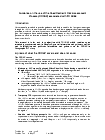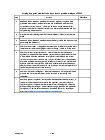Standards for Highways online resources
Information on the design, construction and maintenance of highways for construction professionals.
Highways England produces standards and documentation relating to the design, construction and maintenance of highways.
These documents are available to use under the open government licence.
You can buy paper copies of current documents or complete sets of documents on CD from the TSO bookshop.
To ask questions or obtain copies of superseded documents, contact Standards_Feedback&Enquiries@highwaysengland.co.uk
Note that unpriced Highways England documents relating to traffic systems and signing are held in the Traffic Systems and Signing (TSS) plans registry.
The Design Manual for Roads and Bridges
The Design Manual for Roads and Bridges (DMRB) contains information about current standards, advice notes and other published documents relating to the design, assessment and operation of trunk roads, including motorways.
The DMRB has been prepared for trunk roads and motorways. The basis of use of these documents by local highways authorities is given in the DMRB GD 1/08. Check with your local highway authority for their policy on this matter.
The DMRB was introduced in 1992 in England and Wales, and following that in Scotland and Northern Ireland. Some standards and specifications have annexes specific to each devolved administration. You should contact the relevant devolved authority directly for guidance.
Before using the DMRB, you should read ‘Volume 0 - Introduction and General Requirements’ (PDF, 201K) for information on the use of the DMRB documents.
- Volume 0 - Introduction and General Requirements
- Volume 1 - Highway Structures: Approval Procedures and General Design
- Volume 2 - Highway Structures: Design (Substructures & Special Substructures), Materials
- Volume 3 - Highway Structures: Inspection & Maintenance
- Volume 4 - Geotechnics & Drainage
- Volume 5 - Assessment & Preparation of Road Schemes
- Volume 6 - Road Geometry
- Volume 7 - Pavement Design & Maintenance
- Volume 8 - Traffic Signs & Lighting
- Volume 9 - Traffic Control & Communications
- Volume 10 - Environmental Design
- Volume 11 - Environmental Assessment
- Volume 12 - Traffic Appraisal of Road Schemes
- Volume 13 - withdrawn
- Volume 14 - withdrawn
- Volume 15 - Economic Assessment of Road Schemes in Scotland
The Manual of Contract Documents for Highway Works
The Manual of Contract Documents for Highway Works (MCHW) contains the primary documents required for the preparation of contracts for trunk road works. It consists of several parts, including the administrative procedures for its use, the specification for highway works and the corresponding method measurements.
‘Volume 0 - Introduction to the Manual of Contract Documents for Highway Works’ (PDF, 167K) gives information on the use of the MCHW documents.
- Volume 0 - Manual Contract Document for Major Works and Implementation Requirements
- Volume 1 - Specification for Highway Works
- Volume 2 - Notes for Guidance on the Specification for Highway Works
- Volume 3 - Highway Construction Details
- Volume 4 - Bills of Quantities for Highway Works
- Volume 5 - Contract Documents for Specialist Activities
- Volume 6 - Departmental Standards and Advice Notes on Contract Documentation and Site Supervision
Interim Advice Notes issued by Highways England
Interim Advice Notes (IANs) issued by Highways England contain specific guidance, which should only be used in connection with works on motorways and trunk roads in England, subject to any specific implementation instructions contained within an IAN.
IANs are not part of the DMRB and the MCHW but must be read in conjunction. They may incorporate amendments or additions to documents in these manuals.
Eurocodes
As a public body, Highways England expresses its requirements for the design and modification of existing structures (including geotechnical works) in terms of Eurocodes. Highways England’s technical experts were involved in the drafting of the Eurocodes and the National Annexes.
Queries regarding Highways England’s implementation of Eurocodes should be addressed to: eurocodes@highways.gsi.gov.uk.
Background information
Network Management Manual and Routine & Winter Service Code
The Network Management Manual (NMM) provides mandatory requirements, guidance and advice for the management of maintenance of the trunk road network. The current version is issue 1, amend number 8, dated July 2009. This replaces version 5.10, amend number 2, dated January 2007.
The performance requirements for routine and winter service activities on the trunk road network are included in the Routine and Winter Service Code. The current version is version 5.10 amend number 3, dated July 2009. This replaces version 5.10, amend number 2, dated January 2007.
Technology Management and Maintenance Manual
The Traffic Management and Maintenance Manual, published January 2013, sets out requirements for the management and maintenance of traffic technology systems.
Road restraint systems and safety barriers
These resources all relate to road restraints and safety barriers. You may also be interested in the following archived research reports:
- research into the travel of errant vehicles as they leave the carriageway and the factors that might affect this
- research into the performance and cost effectiveness of median barriers installed on major roads in Britain
Road Restraints Risk Assessment Process
The Road Restraints Risk Assessment Process (RRRAP) is part of the New Road Restraints Standard TD 19 and enables designers to determine the need for a vehicle restraint and associated performance requirements.
The Risk-based Road Restraint Systems Standard does not follow the traditional format as it has two parts that must be used together. The first part is the RRRAP issue 1.3a dated 5 December 2011. The second part is standard TD19 ‘Requirement for Road Restraint Systems’, which contains some mandatory requirements but gives mainly advice and guidance.
The RRRAP is in Excel and enables the designer for each site/scheme to establish the need for a vehicle restraint and, if so, its performance requirements. If you have trouble downloading this file this may be because your security settings do not allow you to download files that contain macros. You can contact the Road Restraints team at Standards_Feedback&Enquiries@highways.gsi.gov.uk to request a copy of the files on CD.
Note that some aggressiveness factors for hazards were modified between RRRAP issues 1.3 and 1.3a to remove anomalous and unexpected results.
In Northern Ireland, TD 19 and the RRRAP were implemented from 1 August 2007. For further information please contact the Engineering Policy Branch on 02890540405.
Using the RRRAP
You can use to copy input data from an old version of the RRRAP to the latest version. For this to work you will need to rename your old file to OSP.xls and your new file to NSP.xls. These temporary names can be changed once the data copying is complete.
A Guidance Manual is available below which will take you through a step by step process of using the RRRAP.
If you have any questions or problems with the RRRAP then please consult the RRRAP problem check sheet available below for commonly encountered problems before contacting us.
This worked example is a spreadsheet with basic details already filled out. It can be used to verify IT system issues or examine problems with data entry.
Advice for low flow trunk roads in Wales and Scotland
The RRRAP allocates an aggressiveness value to each hazard adjacent to the road and quantifies risk by estimating the equivalent fatalities per vehicle km. For very aggressive objects adjacent to high speed roads, the RRRAP indicates that the provision of a Vehicle Restraint System (VRS) is required to lower the risk to an acceptable level, regardless of the traffic flow.
However, as traffic flow decreases the benefit/cost ratio of solutions also decreases. This is because although the overall risk decreases when a VRS is provided, the benefit is relatively small due to the relatively low number of accidents it prevents. Where two-way traffic flows are less than 5,000 AADT the designer should:
- assess whether the outputs from the RRRAP are practicable
- assess if the benefit/cost ratio results warrant VRS provision
- discuss their findings with the Overseeing Organisation
This does not apply to the provision of parapets.
EN1317 Compliant Road Restraint Systems
The EN1317 Compliant Road Restraint Systems list provides a list of road restraints products that have been put through rigorous testing.
The road restraint products in the list are divided into the following categories:
- safety barriers
- temporary safety barriers
- parapets
- terminals
- vehicle attenuators
- transitions
- crash cushions
- miscellaneous
Each category states what standards the products have been tested against and specifies the “containment performance” and “working width” classes that apply to each product.
For more information about the products, please contact the product promoters directly.
Pilots and trials on Highways England roads
Guidance for practitioners involved in the consideration, development, implementation or operation of pilots and trials that will potentially impact on the Highways England road network. Before you begin this procedure you must seek approval using .
Telecom mast registration
Use the to gain technical approval to erect a telecom mast:
- on Highways England land
- within the highway boundary
- that could fall onto Highways England land
Updates to this page
-
Latest version or RRRAP document added
-
Worked example of RRAP added.
-
guidance on using the RRRAP documents added
-
Updated addition of the EN 1317 compliant road restraint system added
-
List of EN 1317 compliant road restraint systems updated
-
Content migrated from standardsforhighways.co.uk
-
First published.











